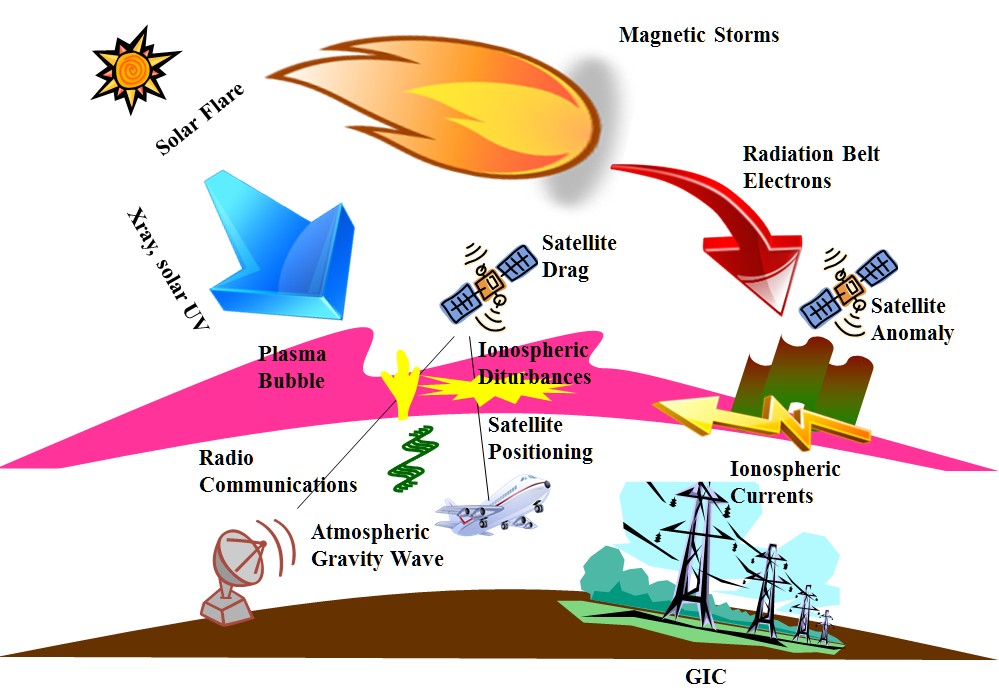- Steering Committee
- A01 Group: Space Weather Forecast System
- A02 Group: Solar Storms
- A03 Group: Geospace Dynamics
- A04 Group: Solar Cycle Activity and Impact on Climate
Steering Committee
Objective
The steering committee intends to maximize the research results of the project by collaborating with the research groups and proposal-based research units. Thus, we will able to determine the appropriate research strategy from a broad perspective and achieve effective management based on an objective self-evaluation. Moreover, we will strengthen cooperation within related academic communities, industries, as well as international partners, as well as promote the development of human resources that could guide the study from a point of view that connects both science and society. Furthermore, we will play an active role in disseminating the research to the public as a whole.
Plan
The steering committee will coordinate the organic cooperation of the research groups and proposal-based research units. Moreover, we will summarize the research results to create an assessment report of severe space weather disasters. In addition, we will organize domestic and international symposiums, as well as conduct summer school classes to contribute to the improvement of solar-terrestrial studies. Furthermore, we will promote the support of young scientists, the outreach activities, and the application of space weather prediction in cooperation with project members.
A01 Group: Space Weather Forecast System
Objective
Space weather affects telecommunications, broadcasts, satellite navigation, satellite operation, and the power grid. Social infrastructure has developed without any consideration of space weather effects; thus, once a severe space weather phenomenon occurs, the impact on human society could be considerable. Recently, the International Civil Aviation Organization cited the use of space weather information as one of the indispensable meteorological data sets. This highlights the requirement for an increase in space weather information; however, at present, space weather research in Japan is primarily academic and does not provide useful information to the public. In this study, our aim is to construct frameworks for robust social infrastructures against space weather disasters, on the basis of cutting-edge scientific results by joining the forces of scientists and relevant business leaders. Moreover, from a scientists’ perspective, we expect to determine research targets that fit societal requirements. One of the characteristics of this project is to promote the utility of space weather data as useful information in society by establishing interactive communication between the researchers and the users. The A01 group is working toward investigating and adjusting its scientific goals for alignment with the user’s needs. In addition, the A01 group is working to connect with the other planning research groups.
Plan
A01 plans to work on the following themes concerning the interactive communication system: (1) addressing the gap that exists between the scientific products provided by the A02–04 groups and the requirement of the users, the government, and companies; and (2) discussing the connection between the model and the simulation code provided by A02–04 in view of societal utilizations and feedback for improvements by their researchers. Note that we will have regular meetings to discuss these issues with the government and business users of space weather data.
A02 Group: Solar Storms
Objective
The space environment surrounding the Earth is a violent world filled with ultraviolet and X-ray radiations, high-energy particles, and a wind of magnetized plasma emanating from the Sun. The behaviors of all of these elements change drastically with time, and it is now known that the “solar-terrestrial environment” causes significant impacts on the environment of the Earth and human society. This project aims to improve our capability for predicting the solar-terrestrial environment by understanding the mechanism of solar explosions and the propagation of the consequent disturbances to the Earth using physics-based models. To this end, we pursue the following scientific objectives:
- Develop a reliable scheme for predicting the occurrence of large-scale solar explosions by identifying its trigger mechanism using high-precision measurements of the magnetic fields on the Sun and advanced modeling based on physical principles.
- Establish a methodology for forecasting solar storms that reach the Earth within several hours of the occurrence of the solar explosion by combining optical and radio observations and advanced modeling of the solar wind, CME, and high-energy particles.
In addition to these objectives, we will pursue the following as an extended goal:
- Form the basis for a next-generation space weather forecasting using a scheme for predicting the occurrence of large solar flares in a quantitative way from the synergetic combination of observations and modeling.
Facilities for solar observation to be used in this project are now operational at individual institutions, and some of the observing systems to be updated are ready for development. Outcomes from this project will be widely distributed to the public via social media and web pages in close collaboration with the management team of PSTEP.
Plan
The science objectives of this project will be achieved by observing the evolution of the magnetic fields in the solar photosphere and chromosphere before explosions, by observing the ascending motions of erupting filaments, and by observing the shock waves and coronal mass ejection (CME) propagating in the corona as a whole; moreover, this would be possible by coordinating with the observation facilities located at participating institutions and universities. The observed processes will then be reproduced using numerical modeling based on magnetohydrodynamics. First, Hinode will be used to obtain the photospheric magnetic fields at the highest precision available to date while NAOJ will observe the chromospheric magnetic field. Then, the data will be compared with a recently developed numerical model of flares to understand the mechanism of the explosion. In this manner, an effective methodology for predicting flare occurrences will be developed. Second, the occurrence and propagation of CME will be observed closely by multiple institutions. The ascending velocity of erupting filaments will be observed by the SMART telescope at Kyoto University; shock waves excited in the corona will be observed by the new monitoring system of the solar radio burst at NICT; and CME propagating toward the Earth will be observed by the inter-planetary scintillation observing system at Nagoya University. These data will provide the initial conditions for precise numerical modeling based on magneto-hydrodynamics and the kinematics of high-energy particles; thus, the disturbance of the solar wind and the variation of the solar proton flux at Earth’s orbit will be quantitatively predicted. In this project, we will update two observing systems to provide advanced data sets on solar eruptions: a new high-sensitivity infrared camera will be installed on the magnetograph at NAOJ to improve sensitivity to the chromospheric magnetic field by a factor of five compared to before, and a new Doppler imaging system will be installed at Hida observatory at Kyoto University to capture for the first time the dynamic motion of erupting filaments moving toward the Earth. 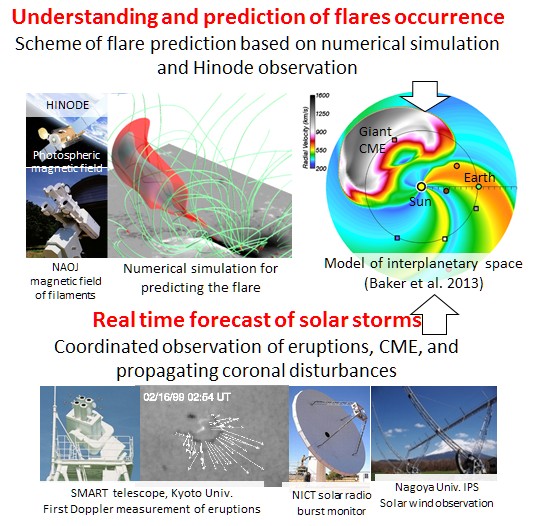
A03 Group: Geospace Dynamics
Objective
Disturbances from the Sun and the solar wind cause several severe variations in Geospace: enhancement of energetic particles in the Van Allen belts; deep penetration of solar protons; electron density variations at ionospheric altitudes such as plasma bubbles; and geomagnetically induced current (GIC). These space weather phenomena are considered as natural disasters that could cause severe impacts on our modern life and serious damage to our modern infrastructure, including malfunctioning of satellites, blackout of telecommunications, and catastrophic disruption of power grids. The aim of this research group is to develop models and forecast systems to evaluate how space weather phenomena (space radiation environment, ionospheric density disturbances, and GIC) vary along with the variations of the Sun and the solar wind. Moreover, this research group will try to improve forecasting skills by comparing model/forecast systems and observations. We will use the new observation data from the Japanese ERG satellite that will be launched in 2016; the ionospheric disturbance data from the ground-based multi-points network, which is the largest ground-based network in the world; and the GIC data from collaborative studies with the power company. Experts in both satellite/ground-based observations and simulations will be a part of this team, which is essential for positive research by integrating modeling/forecasts with the observations. This group will contribute to forecasting of radiation exposure to astronauts, as well as positioning errors, GIF, and alerts to the radio wave communications that are closely related to our modern life, which will be available to the public through the A01 group. Our group’s results will also contribute to sustaining our modern way of life, which is clearly different from the objectives of previously conducted space weather research.
Plan
The aim of this research group is to develop models and forecast systems to evaluate how space weather phenomena (space radiation environment, ionospheric density disturbances, and GIC) vary along with the variations of the Sun and solar wind. Many phenomena in Geospace have been modeled and are well understood using magnetohydrodynamics (MHD); however, MHD is not always sufficient to understand these phenomena. This research group consists of sub-research groups for space radiation, ionospheric disturbances, and GIC. Each sub-research group will develop component models for each phenomenon and attempt to forecast their variations along with the variations of the Sun and solar wind. The space radiation sub-group will develop a physics-based model of the radiation belts based on a quasi-linear approach and nonlinear simulations to calculate wave particle interactions and the acceleration of energetic particles. Subsequently, this model will be used to forecast space radiation. The ionosphere sub-group will integrate a component model that can calculate mesoscale phenomena such as plasma bubbles in the ionosphere to a global model that has already been developed by other members. Note that the component model will be used to forecast ionospheric disturbances triggered by solar flares and the generation and propagation of plasma bubbles that could cause a blackout of radio communications. The GIC sub-group will estimate the global GIC distributions using the magnetosphere/ionosphere currents. Moreover, this sub-group will develop accurate mapping of ground-conductivity around Japan and will reveal where strong GICs triggered by solar wind disturbances can be observed in Japan. The performance of the models developed in this group will be evaluated via a quantitative comparison with the data from the ERG satellite observations, the ground-network observations for ionosphere/thermosphere, and the GIC, which will be essential for improving the model.
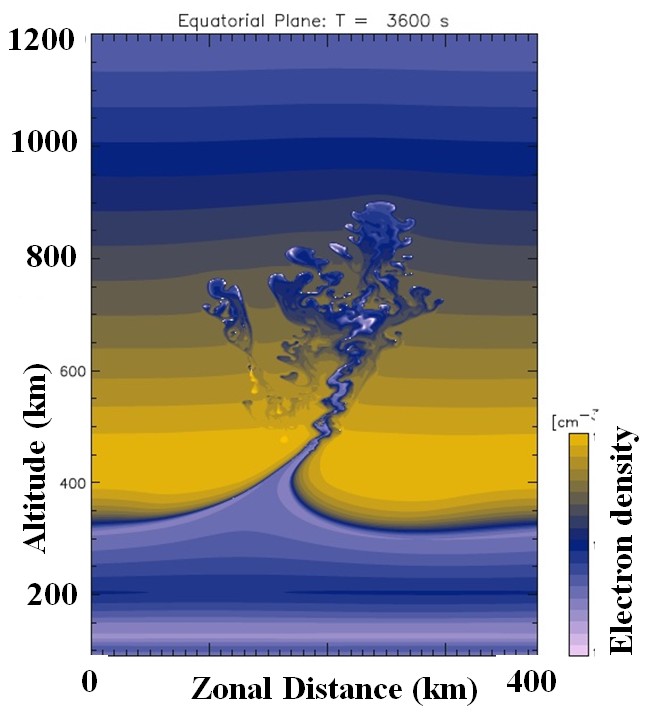 |
| Computer simulation of a plasma bubble at ionospheric altitude (Yokoyama et al., J. Geophys. Res., 2014). The strong density gradients of the plasma bubble occur because of the plasma instability, which causes ionospheric scintillation. We will attempt to forecast the generation and propagation of such ionospheric bubbles. |
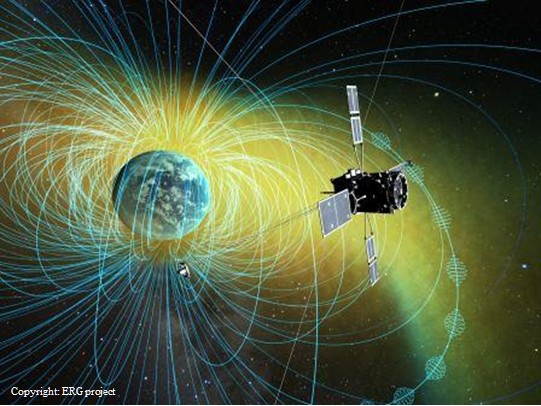 |
| The Geospace exploration satellite ERG, which will be launched in 2016. The satellite will observe plasma/particles in a wide energy range as well as electric/magnetic fields (copyright: ERG project) |
A04 Group: Solar Cycle Activity and Impact on Climate
Group A04:
Prediction of solar cyclic activity and evaluation of its impact on climate and the environment of the Earth
Objective
The 11-year solar cycles and the longer-term variations of solar activity, such as the Maunder Minimum in the 17th century, are possible natural causes of climate variability (Figure 1). However, we have not yet achieved sufficient scientific understanding of how various elements associated with solar activity might affect the terrestrial environment and climate. This lack of understanding results in one of the major causes of uncertainty in future climate simulation. The activity of Solar Cycle 24, which is the current solar cycle, is considered to be the least since Cycle 14, which had a maximum in 1906. However, the reasons for such an anomalously inactive cycle are still unknown. Note that predicting the next solar cycle is essential for predicting the “solar-terrestrial environment” for the next several decades; moreover, constructing a scientific infrastructure for this purpose is urgently required. This group aims to develop a prediction scheme for the activity level of the next solar cycle by combining the latest solar dynamo models and the most accurate measurements of solar magnetic fields. We will also apply our prediction scheme to long-term variations of solar activity and investigate the possibility of a grand minimum such as the Maunder Minimum in the foreseeable future. Moreover, we will implement the solar related effect (e.g., galactic cosmic rays and long-term change in the total solar irradiance as well as spectral solar irradiance) into the atmospheric part of the Meteorological Research Institute Earth system model. Note that improved climate model simulations will help identify the main physical mechanisms for how fluctuations in the solar activity affect the weather and climate system.
 |
| Figure 1 |
Plan
For this study, we will develop a new scheme of solar cycle prediction and study the influence of solar variability on the Earth’s climate using modern sophisticated observations and numerical simulations. Our basic aims are as follows: 1) predict the next solar cycle (Cycle 25) using modern solar observations and numerical simulations, and 2) clarify the physical processes by which the solar variability influence the Earth’s climate. Furthermore, we will investigate the physical mechanism of longer-timescale solar variability (a few hundred years). Moreover, we will conduct numerical reproduction experiments, which will include the influence of solar variability on the Earth’s climate. Research plans of subgroups are as follows:
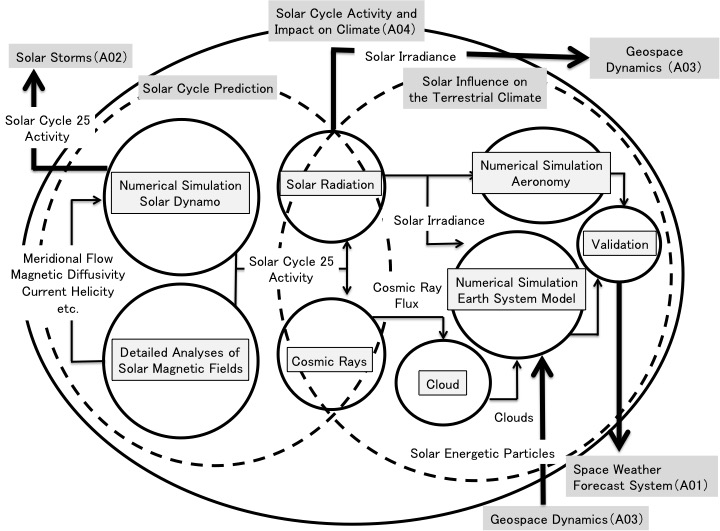 |
| Figure 2 |
Solar cycle prediction:
- Detailed analyses of solar magnetic fields measured by the Hinode satellite and the infrared spectropolarimeter at the National Astronomical Observatory of Japan.
- Solar Cycle 25 prediction using the kinematic dynamo simulation based on the observation parameters (Figure 2).
Solar radiation and cosmic rays:
- Estimation of long-term solar UV radiation based on analyses of solar chromospheric images since 1910.
- Clarification of the relationship between solar activity and solar spectral irradiance.
- Detailed analyses of the variations of galactic cosmic ray flux in the past based on measurements of cosmogenic nuclides in tree rings, ice cores, and lake sediments.
Solar influence on the terrestrial climate:
- Implementation of atmospheric processes related to solar activity into MRI-ESM (Figure 3)
- Performance verification and evaluation by observation data and typical case simulation data based on the Coupled Model Intercomparison Project phase 6, which will be performed for the next IPCC assessment report.
Furthermore, in collaboration with these coordinated subgroups as well as other public research groups, we will promote research on prediction of solar cycle activity and evaluation of its impact on the climate and environment of the Earth to develop a new field of science. Figure 1. Variation of sunspot numbers during the past 400 years. Figure 2. Physical processes of solar variability and its prediction (Nandy et al., 2011) Figure 3. Solar influence on weather and climate systems via some elements based on Gray et al. (2010).
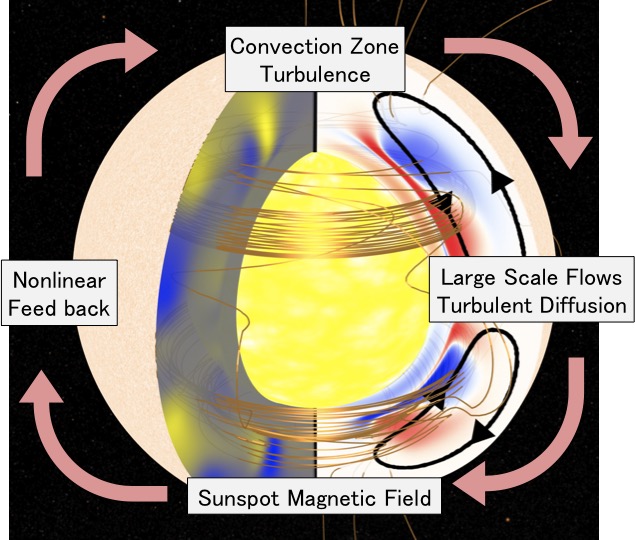 |
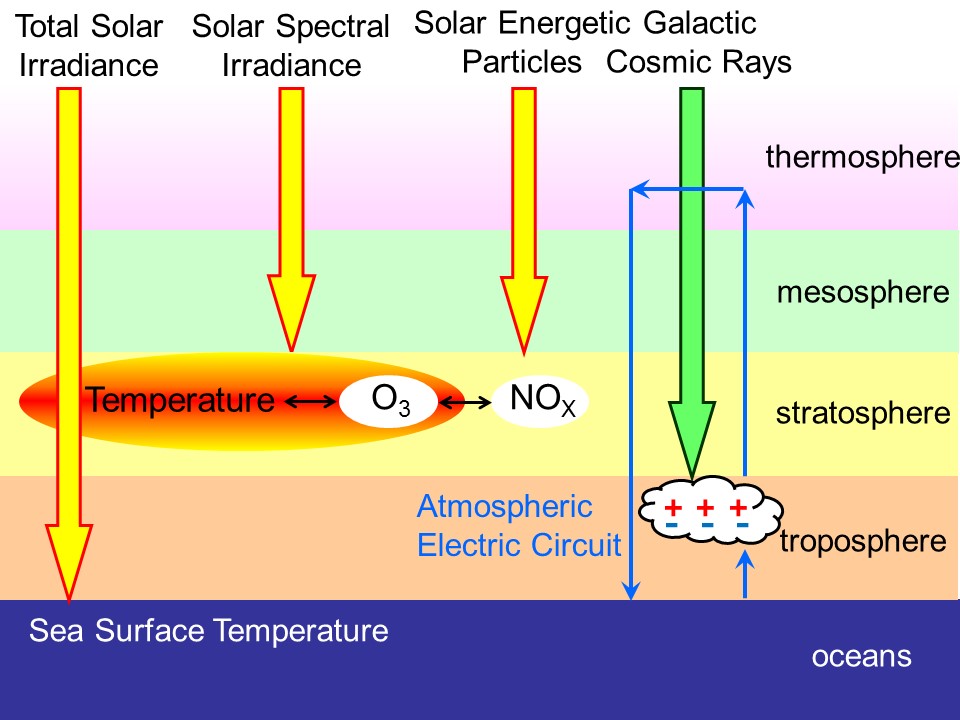 |
| Figure 3 | Figure 4 |

